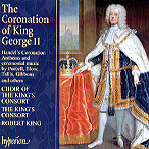File this one under “event”. This is nothing less than an attempt to reconstruct and present–in as much splendor as can be mustered on a recording–the 1727 coronation ceremony of England’s King George II. Fortunately for all concerned, no less a talent than Handel was involved in composing much of the music, and the occasion was further enhanced by the inclusion of gems such as the magnificent Tallis litany O God, the Father of Heaven, Purcell’s I was glad, a Gibbons Te Deum setting, and various fanfares and Handel’s spectacular “grand instrumental procession” music. The proceedings are introduced by the “tolling bell of Westminster Abbey” (where the original ceremony took place–this recording, however, was made at another London location, St. Jude-on-the-Hill) and close with “The bells of London”. You sense that no expense was spared for this project, from researching contemporary accounts (there are some famous discrepancies between what was officially planned and what actually happened) to acquiring, allotting, and aligning the vocal and instrumental forces to create a properly grand–make that splendiferous–impression.
Two discs, no less, are required to document everything from the aforementioned bells (there’s something reassuring and eternal about that sound) to the trumpet fanfare, drum procession, and introductory congregational calls of “Vivat! Vivat! Vivat!”, through all the sections of the service–Recognition, Anointing, Investiture, Crowning, Inthronisation, Homage, Coronation of the Queen, and Recessional. Handel wrote no less than four anthems for this event, some of his most famous works, and they’re all here, in wonderful, vibrant performances–Zadok the Priest, Let thy hand be strengthened, The King shall rejoice, and My heart is inditing. How many times will you actually listen to something like this? I suppose the recording’s producers hope you don’t think about that question very carefully, because the multifaceted, multilayered service, complete with anthems, hymns, various instrumental insertions, and spoken sections for “archbishop” and “congregation”, doesn’t work the way a uniform concert program does. A coronation was a spectacle, enhanced by visual grandeur and a sense of occasion made greater by the presence of royalty and its trappings and traditions. And, grand as it is, music was only a part of the event. To capture a realistic sense of all this on a recording, in spite of the terrific sonics and superb performances we have here–inevitably misses something. If you can accept that and just enjoy this as an excellent historical document (albeit somewhat speculative in some instances), you’re in for a treat. Actually, I’ve already listened to it three times . . .
































